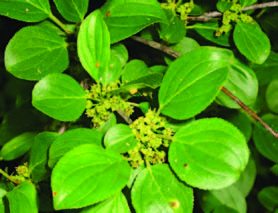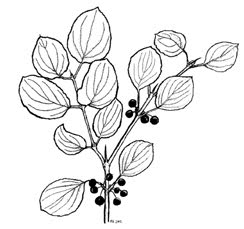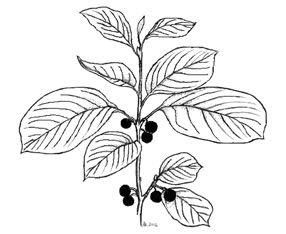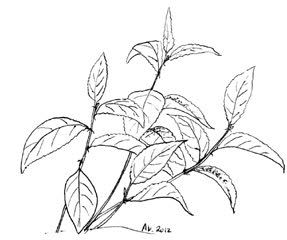Common buckthorn
What you need to know about the common buckthorn. Includes habitat, identifying features and what you can do to reduce its impact.
Common buckthorn (also known as European buckthorn) is a small shrub or tree native to Eurasia. It was introduced to North America in the 1880s as an ornamental shrub and was widely planted for fencerows and windbreaks in agricultural fields. Since then it has spread aggressively throughout southern Ontario and in other provinces.
Common buckthorn can thrive in a wide range of soil and light conditions, enabling it to invade a variety of habitats. It is most often found in woodlands and open fields, where it forms dense stands under which few other plants can grow. Buckthorn can spread widely with the help of birds and animals that eat its fruit, carry the seeds long distances and deposit them in their droppings. Stands of buckthorn can invade roadsides, riverbanks, mature forests, farm fields and hydro corridors.

Common buckthorn leaves and flowers. Photo: Credit Valley Conservation Area
Range
Outside its native range, common buckthorn is found in Canada as far west as Saskatchewan and as far east as Nova Scotia. It also grows throughout the northeastern and north central United States.
Impacts of common buckthorn
- Buckthorn thrives in a variety of habitats and forms dense thickets that crowd and shade out native plants. It can alter nitrogen levels in the soil, creating better conditions for its own growth and discouraging the growth of native species.
- It produces large numbers of seeds that germinate quickly and prevent the natural growth of native trees and shrubs.
- The shrub can host oat rust, a fungus that causes leaf and crown rust and affects the yield and quality of oats.
- The soybean aphid, an insect that damages soybean crops, can use buckthorn as a host plant to survive the winter.
Because it can affect agricultural crops, common buckthorn is listed as a noxious weed under Ontario’s Weed Control Act.

Common buckthorn, showing typical deep green foliage in fall, dominates the lower layers of forests. Photo: Wasyl Bakowsky, MNR
How to identify common buckthorn
- Buckthorn is usually the first shrub to leaf out in the spring and the last to drop its leaves late in the fall.
- It often grows two to three metres tall. Occasionally it reaches six metres, with a trunk up to 25 centimetres in diameter.
- Smooth, dark green leaves are finely toothed, 2.5 to six centimetres long, and arranged in opposing pairs along the stem.
- Most branches older than one year end in a short, sharp thorn.
- Flowers have two to six small yellowish-to-green petals.
- Common buckthorn produces clusters of berry-like black fruit in late summer and fall.
Common buckthorn resembles another invasive species, glossy buckthorn (Frangula alnus), and a much smaller native shrub, alder-leafed buckthorn (Rhamnus alnifolia).
Check the chart below to identify common buckthorn, glossy buckthorn and alder-leaved buckthorn.

Illustration by Andrea Kingsley

Illustration by Andrea Kingsley

Illustration by Andrea Kingsley
| Species | Common buckthorn | Glossy buckthorn | Alder-leaved buckthorn |
|---|---|---|---|
| Traits | (Rhamnus cathartica) (invasive)
| (Frangula alnus) (invasive)
| (Rhamnus alnifolia) (native)
|
What you can do
- Learn how to identify common buckthorn, glossy buckthorn and other invasive plants, and how to effectively manage these species on your property. See the Landowner’s Guide to Controlling Invasive Woodland Plants and Stop the spread of invasive species.
- Avoid using invasive plants in gardens and landscaping.
- Buy native or non-invasive plants from reputable garden suppliers. Native plants provide habitat and food sources for native wildlife. See Grow Me Instead: Beautiful Non-Invasive Plants for Your Garden.
- Dispose of invasive plants in the garbage. Do not put them in the compost or discard them in natural areas. Discarded flowers may produce seeds.
- When hiking, prevent the spread of invasive plants by staying on trails and keeping pets on a leash.
- If you’ve seen common buckthorn or other invasive species in the wild, please contact the Invading Species Hotline at
1-800-563-7711 , or visit Ontario's invading species awareness program to report a sighting.
Other resources:
- Invasive species centre
- Invasive species in Ontario
- Ontario invasive plants council
- Ontario's invading species awareness program
For more information:
Please contact the Invading Species Hotline at

Common buckthorn ripe fruit cluster. Photo: Greg Bales, MNR
This fact sheet may be reproduced for non-commercial purposes. © 2012
Cette publication est également disponible en français.